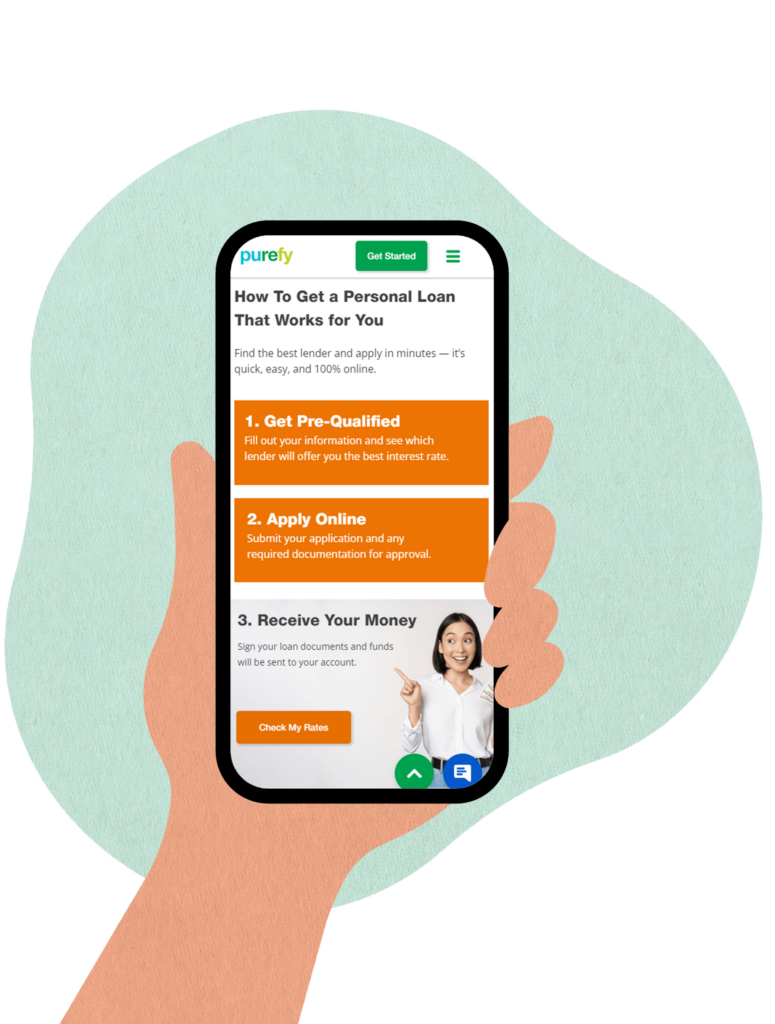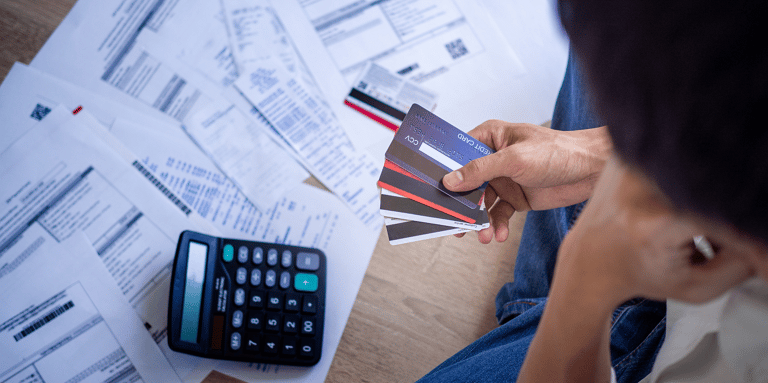High-interest debt is a significant financial burden for millions of Americans, particularly those with credit card debt. With an extra monthly payment and hundreds (or even thousands) of dollars in interest charges every year, it can make it difficult to achieve other financial goals, let alone cover the essentials.
Debt consolidation can provide some relief to eligible borrowers in the form of lower interest rates and monthly payments, as well as a simplified repayment plan. But it’s not for everyone, and depending on your situation, it could do more harm than good.
Let’s take a look at what you need to know about debt consolidation.
What is debt consolidation?
Debt consolidation involves paying off one or more debts with another loan or credit card. There are many different ways to consolidate your debt:
Personal loans
When a personal loan is used to pay off credit card debt, this is often referred to as a debt consolidation loan. Personal loans are often unsecured, which means you don’t need to use an asset as collateral to get approved.
Personal loans can be anywhere from a few thousand dollars up to $100,000, giving most people enough funds to consolidate all of their debt.
They also offer repayment terms ranging from one to seven years, and if you have great credit, you can usually qualify for a fixed interest rate in the single digits. Some lenders charge an origination fee, which can range from 1% to 10%, depending on the lender and your creditworthiness.
Balance transfer credit cards
These cards offer a special introductory promotion, giving you a low or even 0% APR for a period of up to 21 months, depending on the card. While there’s no fixed repayment term, you could save hundreds or even thousands of dollars with a good plan.
Credit cards typically charge an upfront balance transfer fee of 3% to 5%, though there’s no guarantee that your credit limit will be high enough to pay off all of your debt.
Home equity loan
If you have a lot of equity in your home, you may qualify for a home equity loan, which is an installment loan with a fixed interest rate and fixed monthly payment.
The amount you qualify for will depend on how much equity you have in your home — some lenders won’t let the sum of the second mortgage loan and your primary loan exceed 80% of your home’s value, while others may go as high as 100%. Repayment terms can be as long as 30 years in some cases.
Interest rates can be low because you’re using your home as collateral for the loan, but if you can’t pay back the debt, you can lose your house. Additionally, home equity loans can come with closing costs ranging from 2% to 6% of the loan amount.
401(k) loan
If you have a 401(k) plan with your employer, you may be able to take out a loan from your retirement fund. The loan amount depends on how much you have saved, though interest rates can be fairly low. Additionally, any interest you pay goes back into your account, so you’re not paying a lender.
One big perk of a 401(k) loan is that you don’t have to undergo a credit check. But not all 401(k) plan providers offer loans, and if you can’t repay the loan it would be treated as an early withdrawal of your retirement funds, resulting in taxes and penalties. Additionally, withdrawing money will result in lost gains over time.
Credit Card Debt Piling Up?

How much can a debt consolidation loan save you?
If you’re planning to go with a loan instead of a balance transfer credit card, a personal loan is usually best because the potential risks associated with default are much lower compared to home equity loans and 401(k) loans.
With that in mind, here’s what you could potentially save when using a personal loan to consolidate your debt compared to a balance transfer credit card.
Example 1: Lower balance
Let’s say you have $5,000 in credit card debt with a 21% APR and a $150 minimum monthly payment. If you were to keep making the minimum payment, you’d pay off the debt in 51 months, and you’d end up paying about $2,570 in interest over that time — more than half the original balance.
Now, let’s say you can get approved for a 36-month personal loan with a 9% interest rate and no origination fee. With this option, your monthly payment would be $159, but your total interest charges would amount to just $724.
Finally, if you were to get a balance transfer credit card with a 0% APR, a 3% transfer fee, and a 15-month promotional period, you could technically pay off the balance with just $150 in fees. However, your monthly payment would need to be about $344 to make that happen. If you can only afford around $150, you could end up paying more in interest compared to the personal loan.
Example 2: Higher balance
Let’s say you have $15,000 in credit card debt with a 19% APR and a $375 minimum monthly payment. By sticking with the minimum payment, you’d pay off the debt in 64 months, and your total interest charges would be about $8,950.
But let’s say you could get a 48-month personal loan with a 10% interest rate. With this option, your monthly payment would be $380, and your total interest paid would amount to $3,261.
With a balance transfer credit card, you could also save money, but you’ll have a much harder time paying down a high balance within the promotional period. You may not even get approved for a high enough credit limit on the new card to cover your existing balances, making that option less appealing.
Debt Consolidation Calculator
Personal loans can be used to consolidate your debt into a single loan with a new rate and term. See how much you can save by entering your loan information below.
Step 3: See How Much You Can Save
| Current Debt | Personal Loan | Savings | |
|---|---|---|---|
| Monthly Payment | $600 | $483 | $117 |
| Lifetime Interest | $5,400 | $2,399 | $3,001 |
| Time to Payoff Debt | 2 yrs 10 mos | 3 yrs | 2 mos |
Want to compare personalized prequalified rate offers from top personal loan companies? We’ve partnered with Credible to help get your finances back on track with free rate comparisons — with no impact on your credit score.
When is debt consolidation a good idea?
Debt consolidation can potentially save you thousands of dollars, particularly if your credit history is in good shape. But it’s not always the best choice, so it’s important to understand your situation and your options before pulling the trigger.
Here are some situations where it might make sense to use a debt consolidation loan:
- You have great credit: Your best chance of scoring a low interest rate with a personal loan or a balance transfer credit card is if you have good or excellent credit. This typically means having a credit score of 670 or higher, but the higher your score, the better your odds.
- You can afford the monthly payment: Depending on your situation, you may be able to get a personal loan payment that’s similar to your credit card minimum payment. But that’s not always the case, and it’s especially true with a balance transfer card when you have a limited amount of time to save on interest. Run the numbers to determine if the new payment is affordable and won’t stretch your budget too thin.
- You have a high balance: If you only owe a few thousand dollars and can make extra payments, you may be able to save more by focusing all of your energy on paying down your credit card balances quickly. However, if you have a large balance, a personal loan may be a better fit — especially if you’re unlikely to get a high enough limit on a balance transfer credit card.
- You struggle with sticking to a payment plan: While you may be able to accelerate your credit card payments, it can be tough to stay consistent when it’s not a requirement and other expenses arise. With a personal loan, you’ll get a fixed repayment term instead of relying on your own self-discipline with extra credit card payments.
How to find a personal loan to consolidate debt
So, is consolidating debt a good idea? Once you’ve considered your own financial situation and answered this question, it’s important to shop around and find the best approach for your needs.
If you’ve decided to go with a personal loan, it’s important to compare personal loan offers from multiple lenders before you settle on one. In addition to the interest rates, you’ll also want to compare the repayment term options, the upfront origination fee, proposed monthly payments and other features that are important to you.
Fortunately, you can generally do this without officially applying with lenders, so you don’t have to worry about running up a lot of hard inquiries on your credit reports.
Once you settle on a lender, you can apply directly on their website. You’ll usually need to provide some basic information about yourself, such as your name, date of birth, Social Security number, address, and contact information.
You’ll also need to provide your reason for applying, how much you want to borrow, and how much time you need for repayment. Lenders may take anywhere between a few moments to a day or two to provide a decision and underwrite your new loan.
During this time, they may ask you for documentation, such as a copy of your government-issued ID and income verification. If approved, you’ll receive a final offer, which you can review and accept electronically. Then, the lender will either distribute the money to your bank account or directly to your creditors.
Purefy’s personal loan comparison tool is a great place to start, with no obligation to proceed with a loan. And if you have any questions, our award-winning team of loan advisors can help guide you through the process.
Outsmart Rising Credit Card Interest Rates With a Personal Loan
Credit card APRs often exceed 20%. Get your finances on the right track today with a quick & easy personal loan from our marketplace of top-rated lenders













